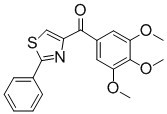|
SMART is a highly potent tubulin inhibitor with IC50 in the nanomolar range (20-30 nM) in a number various cancer cell lines including prostate cancer and melanoma cells. It is discovered by Dr. Duane D Miller's group in the University of Tennessee Health Science Center based on the structure of 2-aryl-thiazolidine-4-carboxylic acid amides (ATCAA), a chemical scaffold designed from lysophosphatidic acid (LPA) with a lipid chain in order to inhibit guanine-binding protein-coupled receptor (GPCR) signaling, which was involved in proliferation and survival of prostate cancer. SMART exerts the anticancer activity by binding to the colchicine binding site of tubulin and inhibiting the polymerization of microtubules, thereby resulting in the inhibition of cell division.
|
Physicochemical Properties
| Molecular Formula |
C19H17NO4S
|
| Molecular Weight |
355.408
|
| Exact Mass |
355.087
|
| CAS # |
1135797-91-9
|
| Related CAS # |
|
| PubChem CID |
25227430
|
| Appearance |
Typically exists as solid at room temperature
|
| LogP |
4.2
|
| Hydrogen Bond Donor Count |
0
|
| Hydrogen Bond Acceptor Count |
6
|
| Rotatable Bond Count |
6
|
| Heavy Atom Count |
25
|
| Complexity |
429
|
| Defined Atom Stereocenter Count |
0
|
| SMILES |
S1C=C(C(C2C=C(C(=C(C=2)OC)OC)OC)=O)N=C1C1C=CC=CC=1
|
| InChi Key |
WZEMDWPKLKAUOH-UHFFFAOYSA-N
|
| InChi Code |
InChI=1S/C19H17NO4S/c1-22-15-9-13(10-16(23-2)18(15)24-3)17(21)14-11-25-19(20-14)12-7-5-4-6-8-12/h4-11H,1-3H3
|
| Chemical Name |
(2-phenyl-1,3-thiazol-4-yl)-(3,4,5-trimethoxyphenyl)methanone
|
| Synonyms |
| (2-Phenyl-thiazol-4-yl)-(3,4,5-trimethoxy-phenyl)-methanone |
|
| HS Tariff Code |
2934.99.9001
|
| Storage |
Powder-20°C 3 years
4°C 2 years
In solvent -80°C 6 months
-20°C 1 month
|
| Shipping Condition |
Room temperature (This product is stable at ambient temperature for a few days during ordinary shipping and time spent in Customs)
|
|
Biological Activity
| ln Vitro |
In vitro activity: Bovine brain tubulin (0.4 mg) (Cytoskeleton, Denver, CO) was mixed with various concentrations (0.625-20 μM) of test compound and incubated in 120 μL of general tubulin buffer (80 mM PIPES, 2.0 mM MgCl2, 0.5 mM EGTA, pH 6.9, and 1 mM GTP). The absorbance of wavelength at 340 nm was monitored every 60 s for 20 min by the SYNERGY 4 microplate reader (Bio-Tek Instruments, Winooski, VT). The spectrophotometer was set at 37 °C for tubulin polymerization. The IC50 value was defined as the concentration which can inhibit 50% of microtubule polymerization.
Cell Assay: Cell Culture and Cytotoxicity Assay of Melanoma. We examined the antiproliferative activity of the ATCAA and SMART analogues in one human melanoma cell line (A375) and one mouse melanoma cell line (B16-F1). We used activity on fibroblast cells as a control to determine the selectivity of these compounds against melanoma. A375 cells and B16-F1 cells were purchased from ATCC (American Type Culture Collection, Manassas, VA). Human dermal fibroblast cells were purchased from Cascade Biologics, Inc., Portland, OR. All cell lines were cultured in DMEM (Cellgro Mediatech, Inc., Herndon, VA), supplemented with 5% FBS (Cellgro Mediatech), 1% antibiotic/antimycotic mixture (Sigma-Aldrich, Inc., St. Louis, MO), and bovine insulin (5 μg/mL; Sigma-Aldrich). Cultures were maintained at 37 °C in a humidified atmosphere containing 5% CO2. Standard sulforhodamine B assay was used. Cells were exposed to a wide range of concentrations for 48 h in round-bottomed 96-well plates. Cells were fixed with 10% trichloroacetic acid and washed five times with water. After cells were air-dried overnight and stained with SRB solution, total proteins were measured at 560 nm with a plate reader. IC50 (i.e., concentration which inhibited cell growth by 50% of no treatment controls) values were obtained by nonlinear regression analysis with GraphPad Prism (GraphPad Software, San Diego,CA). |
|
| ln Vivo |
|
| Animal Protocol |
|
| References |
J Med Chem.2009 Mar 26;52(6):1701-11;J Med Chem.2011 Jul 14;54(13):4678-93.
|
|
Solubility Data
| Solubility (In Vitro) |
| DMSO: soluble (>10 mM) | | Water:<1 mg/mL | | Ethanol:<1 mg/mL |
|
| Solubility (In Vivo) |
(Please use freshly prepared in vivo formulations for optimal results.)
|
| Preparing Stock Solutions |
|
1 mg |
5 mg |
10 mg |
| 1 mM |
2.8137 mL |
14.0683 mL |
28.1365 mL |
| 5 mM |
0.5627 mL |
2.8137 mL |
5.6273 mL |
| 10 mM |
0.2814 mL |
1.4068 mL |
2.8137 mL |
*Note: Please select an appropriate solvent for the preparation of stock solution based on your experiment needs. For most products, DMSO can be used for preparing stock solutions (e.g. 5 mM, 10 mM, or 20 mM concentration); some products with high aqueous solubility may be dissolved in water directly. Solubility information is available at the above Solubility Data section. Once the stock solution is prepared, aliquot it to routine usage volumes and store at -20°C or -80°C. Avoid repeated freeze and thaw cycles. |
